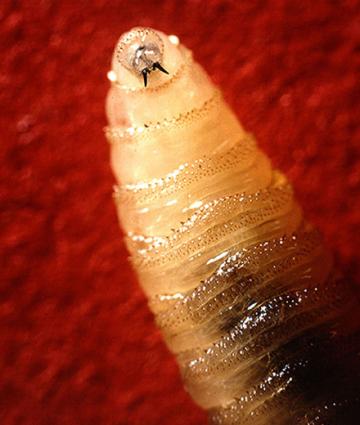ARS Science Key to Stopping ‘Man-Eating’ Parasite

Screwworm larva tear the flesh of warm-blooded animals, costing farmers and ranchers nearly $900 million each year. (Photo by John Kucharski, K7576-1)
Roughly translated, the Latin scientific name for the New World Screwworm – Cochliomyia hominivorax – is maneater. It is an appropriate name.
Though small, the larvae of the blow fly lives up to its name as it burrows into the open wounds of warm-blooded animals, including humans. Through its feeding, larvae enlarge the original wounds, which can lead to infection and death. Fortunately, Agricultural Research Service (ARS)-led scientists managed to drive the pest from North America and are holding the line in Panama.
Screwworm infestations were once prevalent in the United States, with 230,000 cases reported in 1935 alone. ARS scientists Edward Knipling and Raymond Bushland conceived and developed the sterile insect technique (SIT) to control and eradicate screwworms. With SIT, sterilized male blow flies were released to breed with wild flies. Since female blow flies mate only once, the coupling effectively removed that female and her potential offspring from the population.
After eradicating the screwworm from Curacao in 1954, the project moved to Florida and successfully worked its way west across the country before turning south through Mexico and Central America. SIT has been used to suppress or eradicate more than 20 insect pests, but this first use against screwworms has been the most successful.
Eliminating screwworms from the United States saves farmers and ranchers nearly $900 million in lost livestock each year.
According to Alex Arp, research geneticist with the ARS Screwworm Worksite in Panama, the program is relatively simple in description but requires massive efforts from USDA’s Animal and Plant Health Inspection Service and the Panamanian Ministry of Agriculture to rear and apportion the flies. It also requires specially equipped aircraft to release about 14 million sterile blow flies each week into the barrier zone in the Darien region of Panama, along the border with Columbia.
Though highly successful, researchers are always looking for new, better ways to fight screwworms – and new advances in genomics may have opened new doors.
“Sequencing the screwworm genome provides us with information we can use for a multitude of studies,” Arp said. “The genome also contains important information on gene promoter regions that are important for transgenic strain development. Having the genome makes studies of gene expression or silencing much easier.”
Arp and a few others are based in Panama and conduct their screwworm research as part of the Knipling-Bushland U.S. Livestock Insects Research Laboratory in Kerrville, TX. Academic collaborators include scientists at North Carolina State University and the University of Kentucky.
“Genetic technologies such as CRISPR (clustered regularly interspaced short palindromic repeats – a powerful tool for editing genomes) hold much promise for insect control programs including screwworm,” Arp aid. “They can improve our current implementation and, potentially be used to develop gene drive control strategies.” – By Scott Elliott, ARS Office of Communications.

